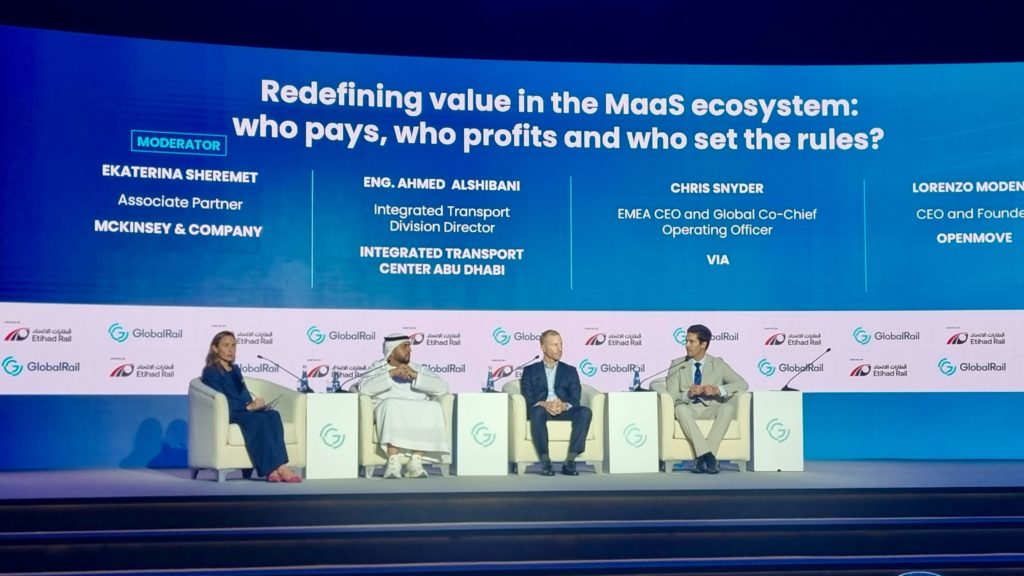At the Global Rail Transport Infrastructure Exhibition & Conference 2025 in Abu Dhabi, our CEO Lorenzo Modena was invited to a panel discussion titled “Redefining value in the MaaS ecosystem: who pays, who profits and who sets the rules?”
The conversation revolved around three simple questions:
- Technology as the backbone – Which digital technologies are proving most critical for MaaS integration today, and how can they scale without excluding smaller operators or undermining user trust?
- Public vs. private priorities – How can governments’ goals of equity and accessibility be balanced with private operators’ need for commercial viability? Where do you see the greatest tensions today?
- Beyond MaaS – If the first wave was about access, what comes next? How do you see mobility evolving into a more intelligent and adaptive ecosystem in the coming years?
During the panel, Lorenzo shared his perspective on these key questions, exploring how openness, governance, and intelligence are reshaping the future of mobility.

Technology as the Backbone of MaaS: Why Openness Beats the “Super App” Dream
When the concept of Mobility as a Service (MaaS) emerged about ten years ago — and OpenMove was born with it — the industry was chasing a dream: the “super app.” One app to rule them all. One bundle to cover every trip, every mode, every user.
That dream didn’t last.
People don’t want a one-size-fits-all experience. Cities are complex. Mobility is personal. The market today is much more mature and aware: the real future of MaaS lies in open, interoperable platforms built on open APIs and shared standards, not in closed systems.
APIs: The Building Blocks of Openness
When we launched api.openmove.com years ago, it started as a technical best practice. But we soon realized it was much more than that — it was a strategic advantage.
Designing OpenMove as an API-first, microservices-based, cloud-native platform has been our way of proving that we’re damn serious — that we’re here for the long haul. (If you want to read more about that, read this blog post).
Because when you’re dealing with complex mobility projects involving many stakeholders, public authorities, and operators, integration is everything. And the only serious way to handle that is to make integration native, not an afterthought.
“APIs are not just about technology, they’re about building an open ecosystem.”
Having a public API layer from day zero means partners and customers can start integrating and testing immediately. It creates transparency, scalability, and trust. APIs are not just about technology, they’re about building an open ecosystem.
Open Standards: The Shape of the Mobility Puzzle
If APIs are the glue, open standards are the shape of the puzzle pieces. Think GTFS for schedules, GTFS-RT for real-time updates, OSDM for ticketing. Standards ensure that mobility works like a mosaic: new tiles can be added, old ones replaced, the picture expanded — all without breaking the system.
This is what keeps MaaS inclusive. Open standards let smaller operators join the ecosystem on equal footing, avoiding vendor lock-in and ensuring that every piece can fit.
Scalability Without Disruption
A scalable, modular architecture is essential in mobility because cities never stop moving. There’s no “day zero” when you can pause everything, rebuild, and restart. Mobility must evolve in motion like performing open-heart surgery.
That’s why we design our systems to grow and adapt: to onboard novel transport modes and new mobility operators, comply with new regulations, or support new business models without disrupting what already works.
Real-Time Data: Turning Uncertainty Into Trust
And finally — real-time data.
We often say people travel twice: once when they plan their journey, and once when they actually move. Public transport often fails in that first journey. Travelers don’t know if the bus is delayed, if they’ll make their train connection, or if they’ll find a scooter waiting for them at the park-and-ride.
“Real-time information builds trust — and trust builds loyalty.”
Real-time information changes that. It builds trust, because people can rely on what they see. And trust builds loyalty which is the foundation of any sustainable shift towards shared and public mobility.
Public vs. Private Priorities in MaaS: Finding Balance on the Same Rails
We already talked about the importance of open APIs and open standards — and as the CEO of a product company, I can’t emphasize that enough. But technology is only one side of the story. The other side is governance.
Let me tell you what happened in Finland in 2017.
That year, alongside Santa bringing gifts to good kids, the Finnish government delivered a groundbreaking reform: the Act on Transport Services. It required transport operators to open up their data and digital access points, so that third parties — the new MaaS operators — could integrate their services.
And it worked. The ecosystem opened up. Innovation flourished. But then something unexpected happened: a short circuit between transport operators and MaaS providers. In their rush to enable competition and digital innovation, the government lost one essential thing — the ability to govern its own mobility system.
“In enabling innovation, Finland lost governance — a reminder that openness must come with structure.”
That’s a lesson the whole sector should learn from.
Distinct Roles, Shared Goals
At OpenMove, we believe the future of MaaS must be built on distinct but complementary roles between the public and private sectors.
Public authorities should manage a national or regional MaaS integration platform — or a central Account-Based Ticketing infrastructure — under public governance. This ensures equity, accessibility, and rule compliance, while safeguarding sustainability and public interest. (We have written about the key ingredients for a successful MaaS here).
Allow me a fitting metaphor:
- The public sector defines the rails: standards, governance, inclusivity, fairness.
- The private sector drives the train: technology, innovation, efficiency, seamless user experience, market reach.
“When each player sticks to their role, we get the best of both worlds: effective governance and healthy competition.”
The public sector can guarantee the rights of the ridership, while the private sector can innovate, optimize, and scale.

The Future of Mobility: From Fragmentation to Intelligence
Today’s mobility landscape is crowded with different players — commuters, tourists, freight operators — all sharing the same stage: our roads and rails. Yet, most of the time, they don’t talk to each other.
Why? Because they’re trapped in siloed systems — each optimized for its own purpose, but unable to interoperate. The result is inefficiency, friction, and a missed opportunity to see the bigger picture.
From Mobility-as-a-Service to Mobility Intelligence
At OpenMove, we believe the next big step is what we call Mobility Intelligence.
Mobility Intelligence is an AI-driven platform that connects every layer of the mobility ecosystem — data, infrastructure, services, and users in a bidirectional loop.
In one direction, it provides real-time control and visibility over the entire mobility landscape: public transport, shared mobility, traffic flow, parking, and beyond. It’s a live, dynamic model of how a territory moves.
In the other direction, it enables authorities and operators to act — to enact policies, steer mobility, and shape the so-called M-curve: balancing demand, reducing congestion, promoting modal shift, and supporting sustainability.
Thanks to this feedback loop, decision-makers can turn “real-time knobs” that immediately propagate across all information and purchase channels, aligning strategy, operations, and user experience in real time.
A Smarter, More Adaptive Ecosystem
This is the future we see: not a patchwork of apps and systems, but an integrated, intelligent ecosystem. One where data flows freely, AI helps make sense of it, and policy can adapt dynamically to real conditions.
Mobility Intelligence bridges the gap between governance and technology, between vision and execution. And ultimately, it brings us closer to what mobility should always have been: simple, efficient, and human-centered.


